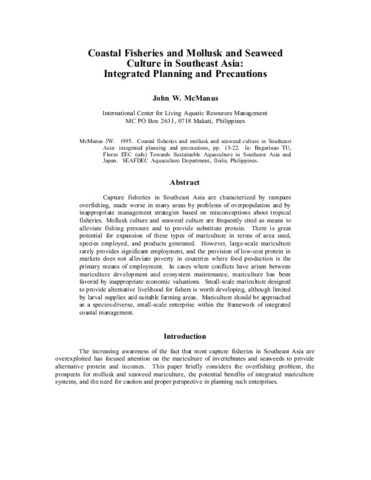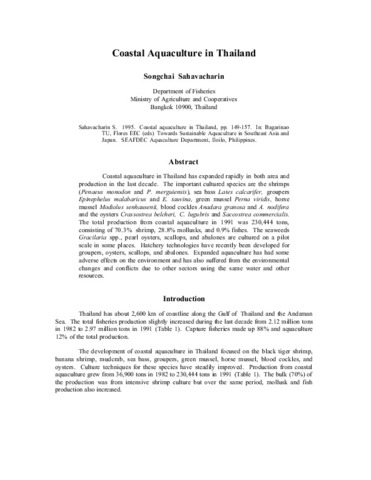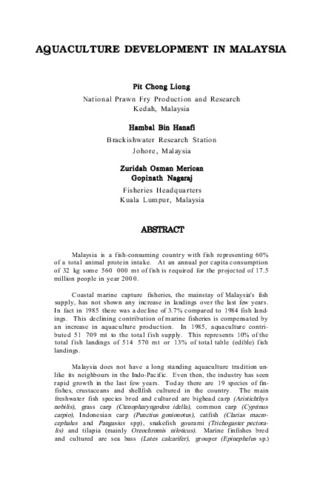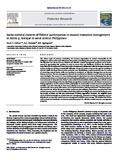Coastal fisheries and mollusk and seaweed culture in Southeast Asia: Integrated planning and precautions
Share
抄録
Capture fisheries in Southeast Asia are characterized by rampant overfishing, made worse in many areas by problems of overpopulation and by inappropriate management strategies based on misconceptions about tropical fisheries. Mollusk culture and seaweed culture are frequently cited as means to alleviate fishing pressure and to provide substitute protein. There is great potential for expansion of these types of mariculture in terms of area used, species employed, and products generated. However, large-scale mariculture rarely provides significant employment, and the provision of low-cost protein in markets does not alleviate poverty in countries where food production is the primary means of employment. In cases where conflicts have arisen between mariculture development and ecosystem maintenance, mariculture has been favored by inappropriate economic valuations. Small-scale mariculture designed to provide alternative livelihood for fishers is worth developing, although limited by larval supplies and suitable farming areas. Mariculture should be approached as a species-diverse, small-scale enterprise within the framework of integrated coastal management.
Suggested Citation
McManus, J. W. (1995). Coastal fisheries and mollusk and seaweed culture in Southeast Asia: integrated planning and precautions. In T. U. Bagarinao & E. E. C. Flores (Eds.), Towards Sustainable Aquaculture in Southeast Asia and Japan: Proceedings of the Seminar-Workshop on Aquaculture Development in Southeast Asia, Iloilo City, Philippines, 26-28 July, 1994 (pp. 13-22). Tigbauan, Iloilo, Philippines: Aquaculture Department, Southeast Asian Fisheries Development Center.
主題
fishery economics  ; Small scale aquaculture; resource management
; Small scale aquaculture; resource management  ; Sociological aspects; integrated coastal zone management
; Sociological aspects; integrated coastal zone management  ; carrying capacity
; carrying capacity  ; environmental impact
; environmental impact  ; overfishing
; overfishing  ; mollusc culture
; mollusc culture  ; aquaculture
; aquaculture  ; Catch/effort; sustainability
; Catch/effort; sustainability  ; aquaculture economics
; aquaculture economics  ; Fishery policy; socioeconomic aspects
; Fishery policy; socioeconomic aspects  ; aquaculture development
; aquaculture development  ; natural resources
; natural resources  ; marine molluscs
; marine molluscs  ; culture effects
; culture effects  ; coastal fisheries
; coastal fisheries  ; Marine aquaculture; seaweed culture
; Marine aquaculture; seaweed culture  ; fish culture
; fish culture  ; Decapoda; Mollusca; South East Asia
; Decapoda; Mollusca; South East Asia
 ; Small scale aquaculture; resource management
; Small scale aquaculture; resource management  ; Sociological aspects; integrated coastal zone management
; Sociological aspects; integrated coastal zone management  ; carrying capacity
; carrying capacity  ; environmental impact
; environmental impact  ; overfishing
; overfishing  ; mollusc culture
; mollusc culture  ; aquaculture
; aquaculture  ; Catch/effort; sustainability
; Catch/effort; sustainability  ; aquaculture economics
; aquaculture economics  ; Fishery policy; socioeconomic aspects
; Fishery policy; socioeconomic aspects  ; aquaculture development
; aquaculture development  ; natural resources
; natural resources  ; marine molluscs
; marine molluscs  ; culture effects
; culture effects  ; coastal fisheries
; coastal fisheries  ; Marine aquaculture; seaweed culture
; Marine aquaculture; seaweed culture  ; fish culture
; fish culture  ; Decapoda; Mollusca; South East Asia
; Decapoda; Mollusca; South East Asia
Collections
- ADSEA '94 [21]
Related items
Showing items related by title, author, creator and subject.
-
Coastal aquaculture in Thailand
Sahavacharin, Songchai (Aquaculture Department, Southeast Asian Fisheries Development Center, 1995)Coastal aquaculture in Thailand has expanded rapidly in both area and production in the last decade. The important cultured species are the shrimps (Penaeus monodon and P. merguiensis), sea bass Lates calcarifer, groupers ... -
Aquaculture development in Malaysia
Liong, Pit Chong.; Hanafi, Hambal Bin.; Merican, Zuridah Osman.; Nagaraj, Gopinath. (Aquaculture Department, Southeast Asian Fisheries Development Center, 1988)Malaysia is a fish-consuming country with fish representing 60% of a total animal protein intake. At an annual per capita consumption of 32 kg some 560 000 mt of fish is required for the projected of 17.5 million people ... -
Socio-cultural context of fishers’ participation in coastal resources management in Anini-y, Antique in west central Philippines
Aldon, Ma. Eva T.; Fermin, Armando C.; Agbayani, Renato F. (Elsevier, 2011)The vicious cycle of poverty, overfishing and resource degradation in coastal communities in the Philippines calls for action that will address the problem of declining fish catch and degraded fish habitats. The literature ...




